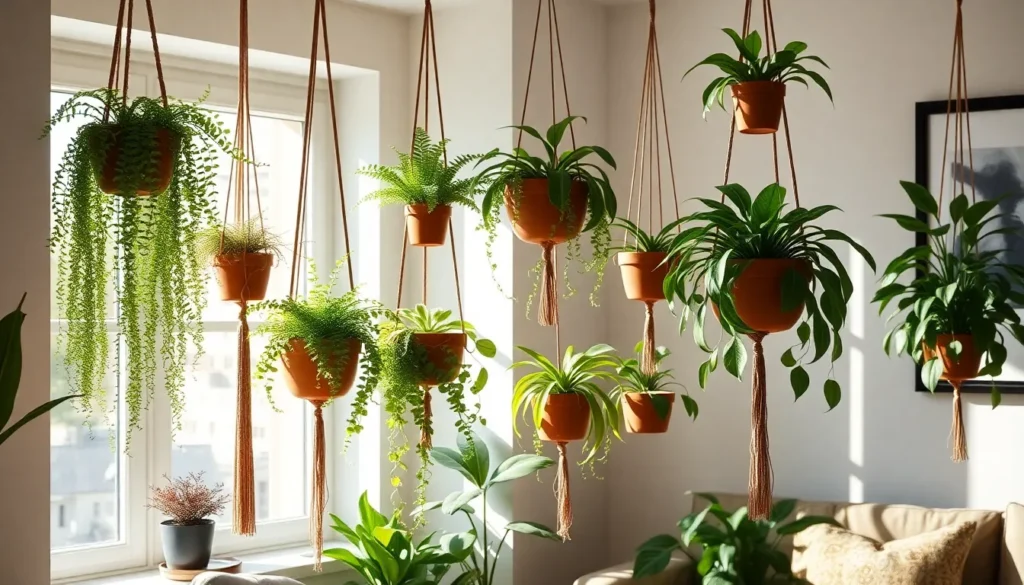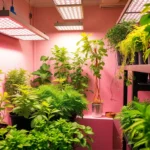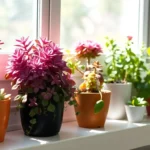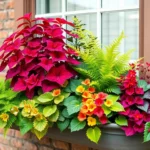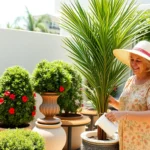We’ve all walked into a room and felt something was missing – that perfect touch to make our living space feel complete and alive. Hanging plants might just be the answer we’ve been searching for. These green beauties don’t just fill empty corners; they transform our living rooms into vibrant sanctuaries that breathe life into every gathering.
Living room hanging plants offer the perfect solution for adding natural beauty without sacrificing precious floor space. Whether we’re working with a cozy apartment or a spacious family room, these suspended gardens create stunning visual interest while purifying the air we breathe. From cascading pothos to elegant spider plants, there’s a hanging variety that’ll complement any décor style.
The best part? We don’t need a green thumb to succeed with these low-maintenance beauties. With the right plant selection and simple care tips, we can create an Instagram-worthy living room that guests will remember long after they leave.
Choose the Perfect Hanging Plants for Your Living Room
Selecting the right hanging plants transforms your living room into a green sanctuary while meeting your exact needs and lifestyle. We’ll guide you through the best options based on lighting conditions, health benefits, and pet safety considerations.
Low-Light Tolerant Varieties
Pothos plants thrive in dimly lit corners where other houseplants struggle to survive. These resilient vines feature heart-shaped leaves that cascade beautifully from hanging baskets, creating stunning visual appeal even in spaces with minimal natural light. We recommend the Golden Pothos variety for beginners since it tolerates neglect and adapts to various lighting conditions.
ZZ plants (Zamioculcas zamiifolia) excel in low-light environments while maintaining their glossy, dark green foliage year-round. Their thick stems store water efficiently, making them perfect for busy homeowners who forget watering schedules. Place these architectural beauties in macrame hangers near north-facing windows for optimal growth.
Snake plants adapt remarkably well to hanging displays even though their traditional upright growing pattern. Choose compact varieties like Sansevieria trifasciata ‘Hahnii’ for hanging arrangements, as they produce stunning vertical lines that add modern elegance to contemporary living rooms.
Air-Purifying Species
Spider plants remove formaldehyde and xylene from indoor air while producing charming baby plantlets that dangle like natural decorations. NASA’s Clean Air Study ranks these prolific growers among the top air-purifying houseplants, making them ideal for improving your living room’s air quality. Their arching green and white striped leaves create movement and texture in any hanging display.
English ivy filters benzene, formaldehyde, and trichloroethylene from your home’s atmosphere according to environmental studies. This classic trailing plant grows quickly in hanging baskets, providing dense coverage that maximizes air purification benefits. We suggest placing ivy near entertainment centers where electronic equipment may release harmful compounds.
Boston ferns excel at removing pollutants while adding humidity to dry indoor environments. These lush, feathery plants require consistent moisture but reward you with exceptional air cleaning capabilities and tropical ambiance.
Pet-Safe Options
Boston ferns rank as completely non-toxic to cats and dogs while delivering impressive visual impact in hanging arrangements. Their delicate fronds create soft textures that complement both modern and traditional living room decor without posing health risks to curious pets.
Spider plants offer peace of mind for pet owners since they’re entirely safe if nibbled by cats or dogs. Many cats actually enjoy playing with the dangling baby plants, providing entertainment for your pets while beautifying your space.
Prayer plants (Maranta leuconeura) feature stunning patterned leaves that fold upward each evening like hands in prayer. These pet-friendly options thrive in hanging baskets and add exotic appeal to your living room without endangering furry family members who might sample the foliage.
Select the Right Hanging Planters and Containers
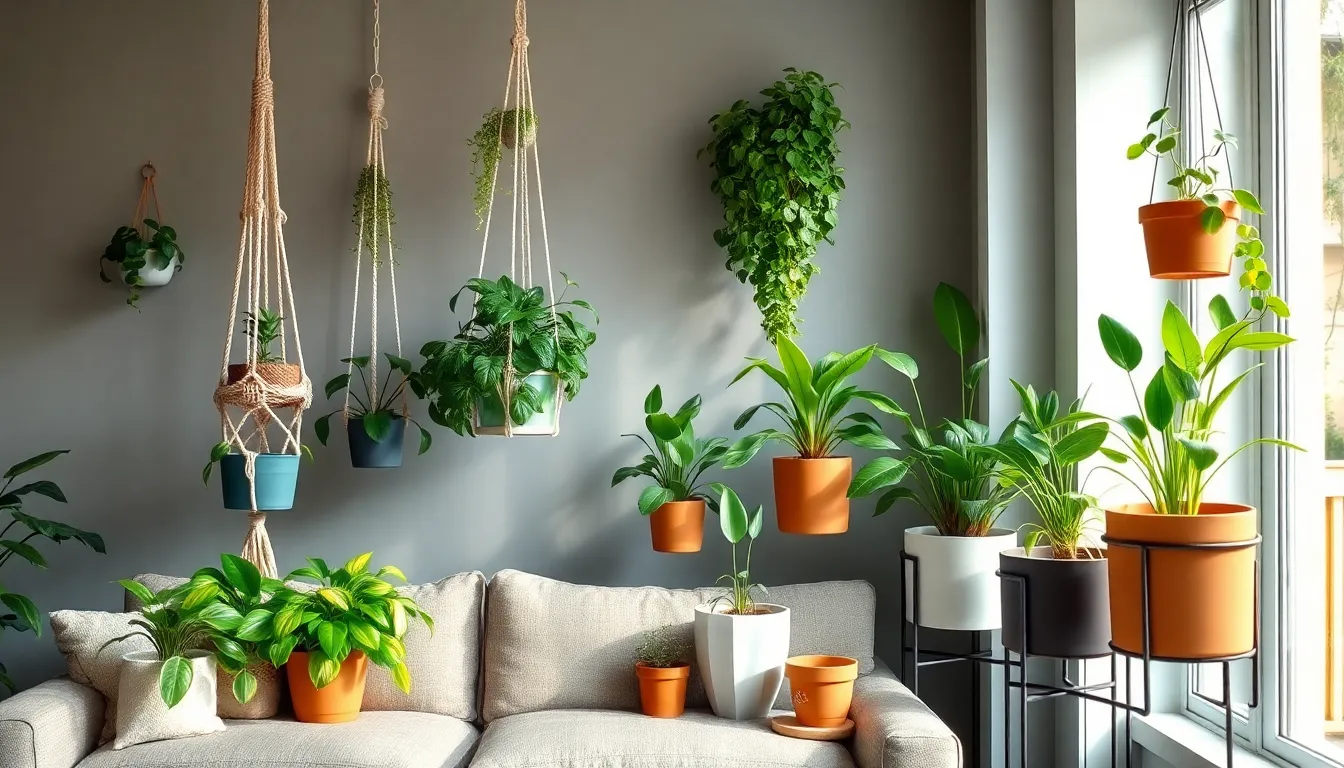
Choosing the perfect planters transforms your living room hanging plants into stunning focal points. We’ll explore three essential container types that combine functionality with style to complement your space perfectly.
Macrame Plant Hangers
Macrame plant hangers bring bohemian charm to modern living rooms while offering incredible versatility for different plant sizes. We love these woven beauties because they’re easy to install and can be customized to fit everything from trailing pothos to compact succulents. Their rope construction creates visual texture that softens hard lines in contemporary spaces. Installation becomes effortless since most macrame hangers simply hook onto ceiling mounts or wall brackets. These hangers work exceptionally well with cascading plants like philodendrons and ivy, allowing the foliage to flow naturally through the woven design.
Ceramic and Terracotta Pots
Ceramic and terracotta pots deliver durability and superior drainage that keeps your hanging plants healthy and thriving. We recommend these materials because they regulate moisture levels naturally while preventing root rot in your ferns and other humidity loving plants. Their porous nature allows air to circulate around root systems, promoting stronger plant growth. These pots come in countless designs and colors, making it simple to match your existing décor style. Weight distribution becomes important with ceramic options, so we suggest using sturdy mounting hardware that can support both the pot and fully watered soil.
Modern Metal Planters
Modern metal planters create sleek, contemporary displays that perfectly complement minimalist living room designs. We appreciate their lightweight construction and easy maintenance, making them ideal for delicate trailing plants like chain of hearts and burro’s tail succulents. Their clean lines add sophisticated elegance without overwhelming your space’s aesthetic. Metal planters resist moisture damage and clean effortlessly with simple wiping, keeping your hanging display looking fresh. These containers work beautifully in clusters, allowing you to create ever-changing vertical gardens that maximize your living room’s visual impact.
Determine the Best Placement for Living Room Hanging Plants
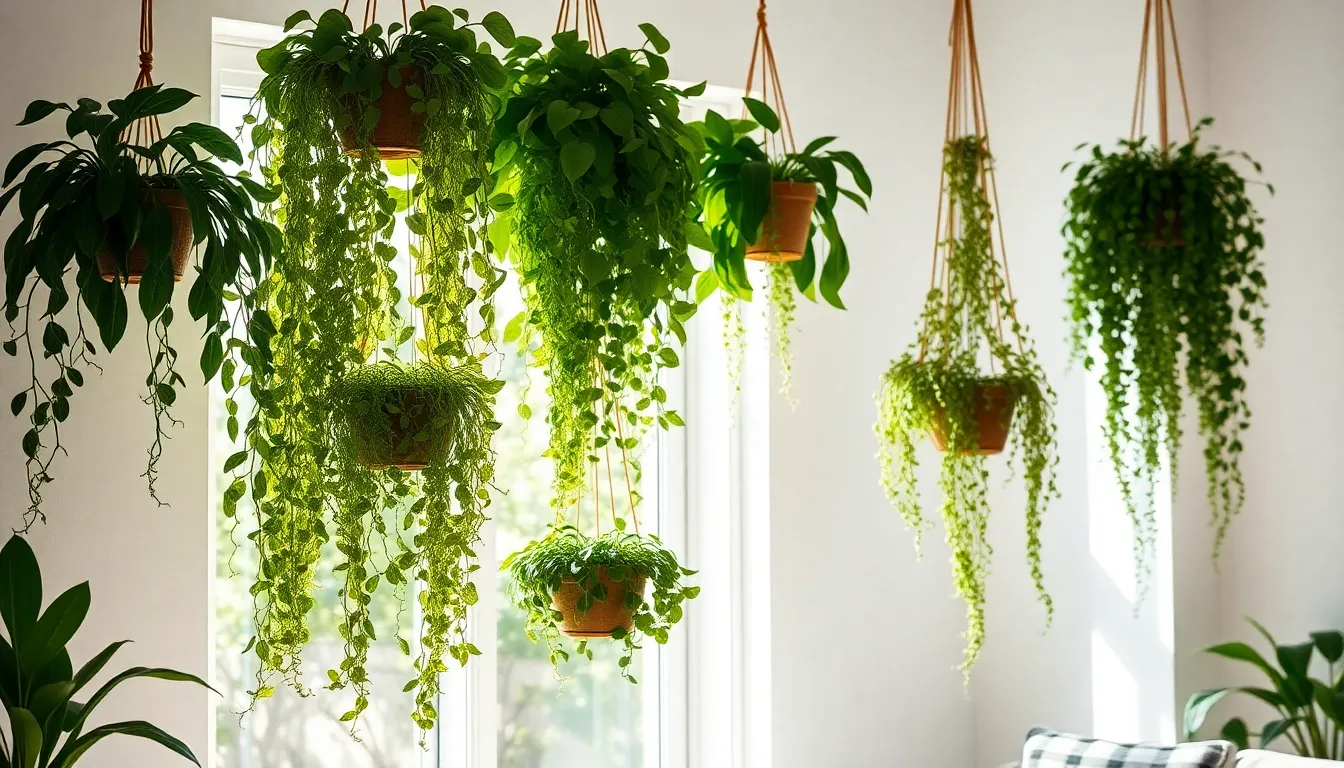
Strategic placement transforms your hanging plants from simple decorations into stunning focal points that enhance your entire living space. We’ll explore three key locations that maximize both visual impact and plant health.
Near Windows for Natural Light
Windows provide the abundant natural light that most hanging plants need to flourish. Positioning trailing varieties like pothos or string of pearls near sunny windows creates what we call “living curtains” that filter sunlight beautifully while maintaining your view. These natural screens offer subtle privacy without blocking natural light completely.
Multiple plants hung at varying heights in front of windows create depth and visual movement. Humidity loving species thrive particularly well near bathroom or kitchen windows where moisture levels stay higher. Herbs like trailing oregano or cherry tomatoes can serve dual purposes when placed in these naturally humid window spots.
Corner Spaces for Visual Interest
Empty corners become ever-changing focal points when filled with strategically placed hanging plants. Boston ferns work exceptionally well as dramatic statement pieces in larger corner spaces where their full fronds can cascade freely. These dead spaces transform into living art installations that draw the eye upward and add vertical dimension to your room.
Clustering smaller plants at different heights creates layered interest in tighter corner areas. This placement balances your room’s overall layout while complementing existing furniture arrangements. Corner positioning also provides plants with light from multiple directions throughout the day.
Above Furniture for Layered Design
Hanging plants above sofas, side tables, or shelving units creates sophisticated layered design effects without consuming precious floor space. This elevated placement draws attention upward and adds natural texture that softens hard furniture lines. Strategic positioning ensures sight lines lead toward focal points like artwork or architectural features.
Dramatic single specimens work particularly well above minimalist furniture where they provide color and movement against clean backgrounds. Plants positioned over furniture should hang at heights that won’t interfere with daily activities while still creating visual impact from multiple viewing angles throughout the room.
Install Proper Support Systems and Hardware
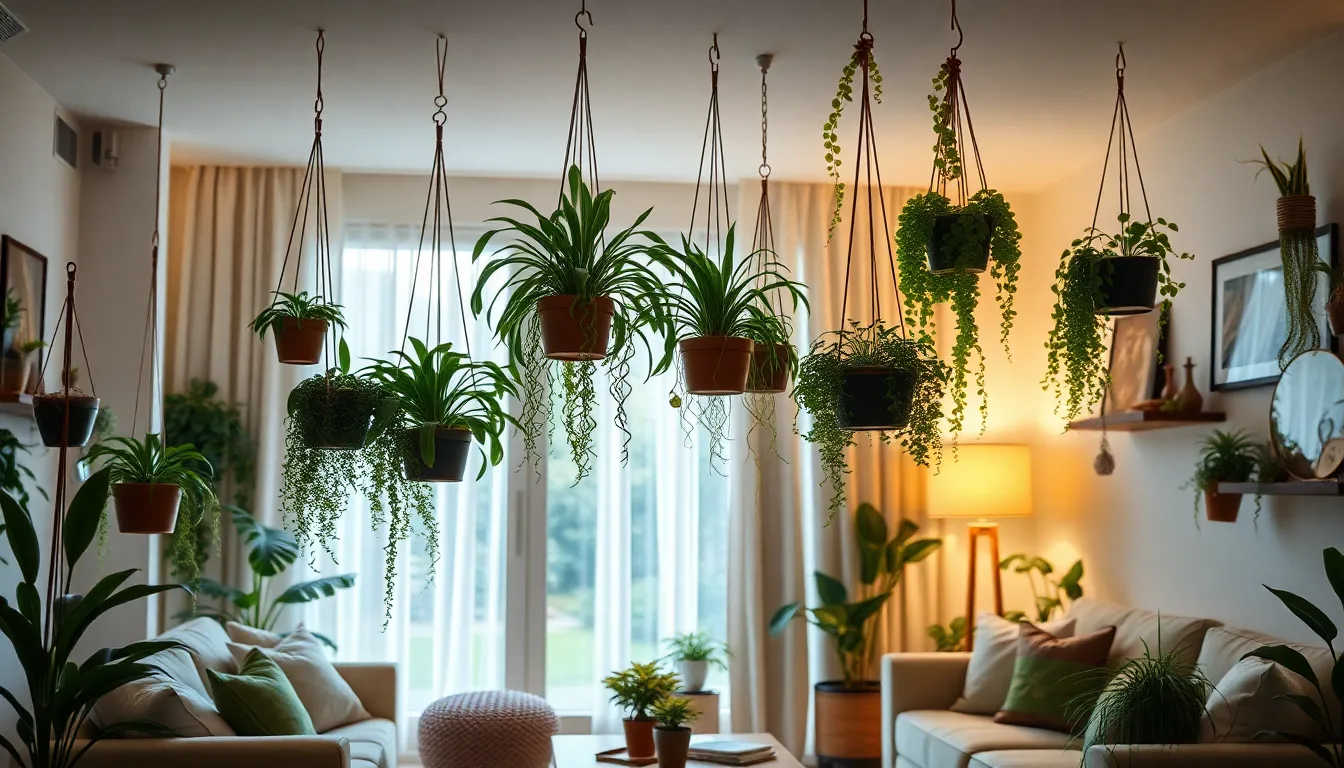
Selecting proper support systems ensures your living room hanging plants stay securely mounted while protecting your ceiling and walls from damage. We’ll explore three reliable installation methods that accommodate different weight requirements and living situations.
Ceiling Hook Options
Hook screws into ceiling joists provide the strongest foundation for heavier plants weighing over 30 pounds. We recommend locating ceiling joists with a stud finder, drilling pilot holes slightly smaller than the screw shaft, then securing heavy duty hooks flush with the ceiling surface.
Swag hooks with toggle bolts work perfectly for drywall ceilings without accessible joists, supporting medium weight plants up to 15-20 pounds. Installation involves drilling holes, inserting toggle bolts through hooks, pushing them through openings, and tightening until completely secure.
Testing hook strength before hanging plants prevents accidents and damage. We suggest pulling down firmly on empty installations or hanging lightweight containers first to verify stability.
Wall-Mounted Brackets
Decorative wall brackets offer versatile alternatives to ceiling mounts while complementing your living room decor. These systems screw directly into wall studs to bear substantial weight and position plants at various heights throughout your space.
Multiple pot brackets maximize vertical growing space by supporting several containers on single mounting points. We particularly recommend these for creating cascading plant displays with trailing varieties like pothos or string of pearls.
Adjustable bracket systems accommodate plant growth and seasonal rearrangements. Installation requires locating wall studs, marking exact positions with pencils, and using ladders for safe mounting at proper heights.
Tension Rod Answers
No drill tension rods provide renter friendly options by installing between walls near ceiling height without permanent hardware. These systems typically support 10 to 30 pounds total weight, making them ideal for grouping multiple lighter plants.
S hook attachments connect easily to tension rods for suspending individual planters. We recommend distributing weight evenly across rod length to prevent sagging and ensure stable plant support.
Corner installations work exceptionally well with tension rod systems, creating living sculptures in unused room spaces. Strategic placement between perpendicular walls maximizes stability while adding vertical interest to empty corners.
Master the Watering and Maintenance Routine
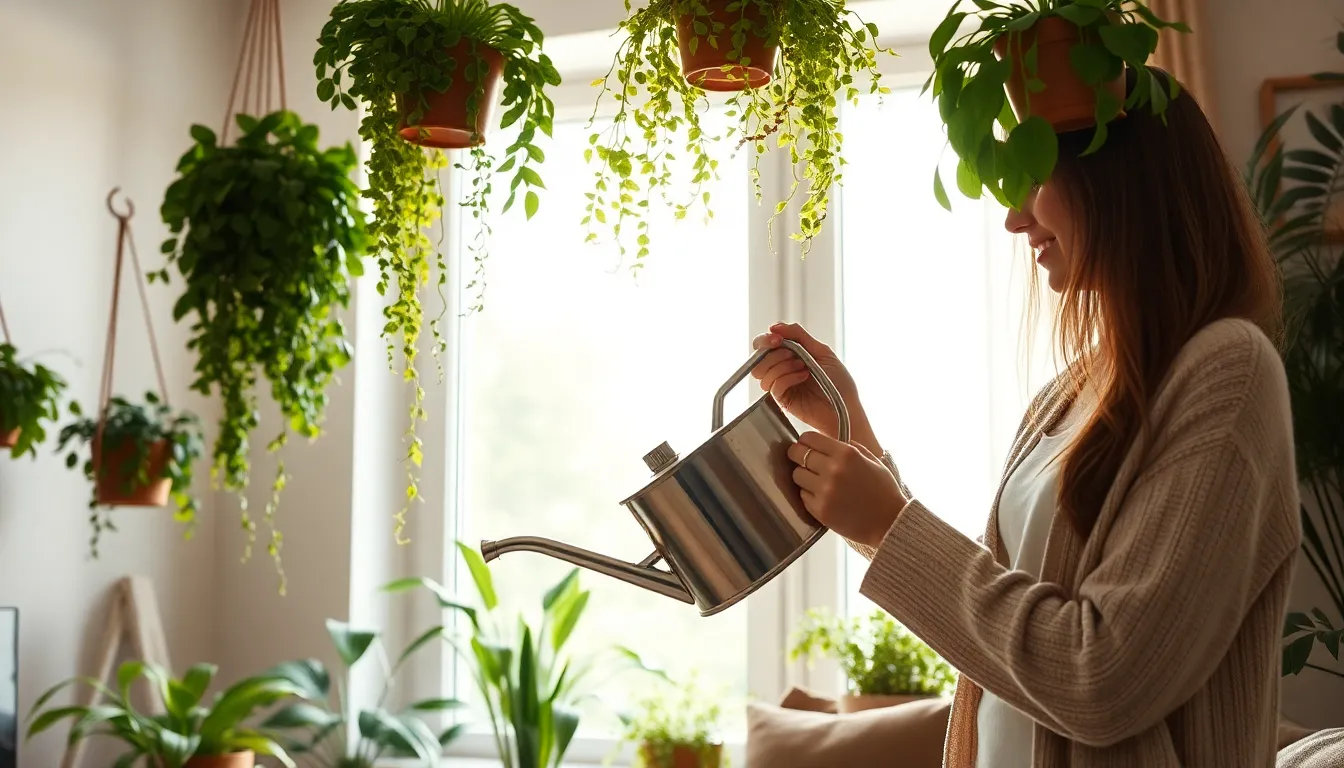
Hanging plants require more attention than ground-level plants since they dry out faster due to increased air circulation. We’ll walk you through the essential techniques to keep your living room hanging plants thriving.
Proper Drainage Techniques
Drainage holes are absolutely critical for preventing root rot in hanging plants. We recommend checking that your hanging pots have adequate drainage holes before planting. Too large pots retain excess moisture while too small containers restrict root growth, so choosing the right pot size matters significantly.
Standing water kills more hanging plants than any other factor. We suggest placing saucers beneath hanging pots to catch excess water, then emptying them within 30 minutes of watering. Eco-friendly pots made from biodegradable plastics or upcycled materials often feature superior drainage systems compared to traditional containers.
Weight distribution becomes crucial when water accumulates in hanging planters. We advise testing your support system with water-filled pots before adding plants to ensure your ceiling hooks can handle the additional weight.
Watering Schedule Guidelines
Weekly watering works for most hanging plants in typical living room conditions. We recommend checking the top inch of soil with your finger before watering. Dry soil indicates it’s time to water, while moist soil means you should wait another day or two.
Environmental factors dramatically affect watering frequency in your living room. We’ve found that warmer or drier environments require watering twice per week, while cooler, more humid rooms may only need weekly attention. Room humidity, pot size, and plant type all influence your exact schedule.
Long-spouted watering cans make the job easier when reaching hanging plants. We suggest using spray bottles for smaller plants or investing in extendable watering tools for hard-to-reach containers. Always water thoroughly until excess drains from the bottom holes.
Pruning and Grooming Tips
Dead and yellowing leaves drain energy from your hanging plants unnecessarily. We recommend removing these weekly using clean scissors or pruning shears to encourage healthy new growth. Fresh cuts should be made just above leaf nodes or healthy stems.
Leggy stems create an unkempt appearance in trailing plants like pothos and spider plants. We trim these back to promote bushier growth, especially important for living room displays where appearance matters. Cutting just above growth nodes encourages multiple new shoots.
Dust accumulation blocks photosynthesis on hanging plant leaves more than ground plants. We wipe leaves monthly with a damp cloth to remove dust and improve light absorption. Clean leaves also make your living room plants look more vibrant and healthy.
Spent flowers redirect energy away from foliage in flowering hanging plants. We pinch off dead blooms immediately to keep energy focused on leaf production and overall plant health.
Create Stunning Visual Impact with Arrangement Techniques
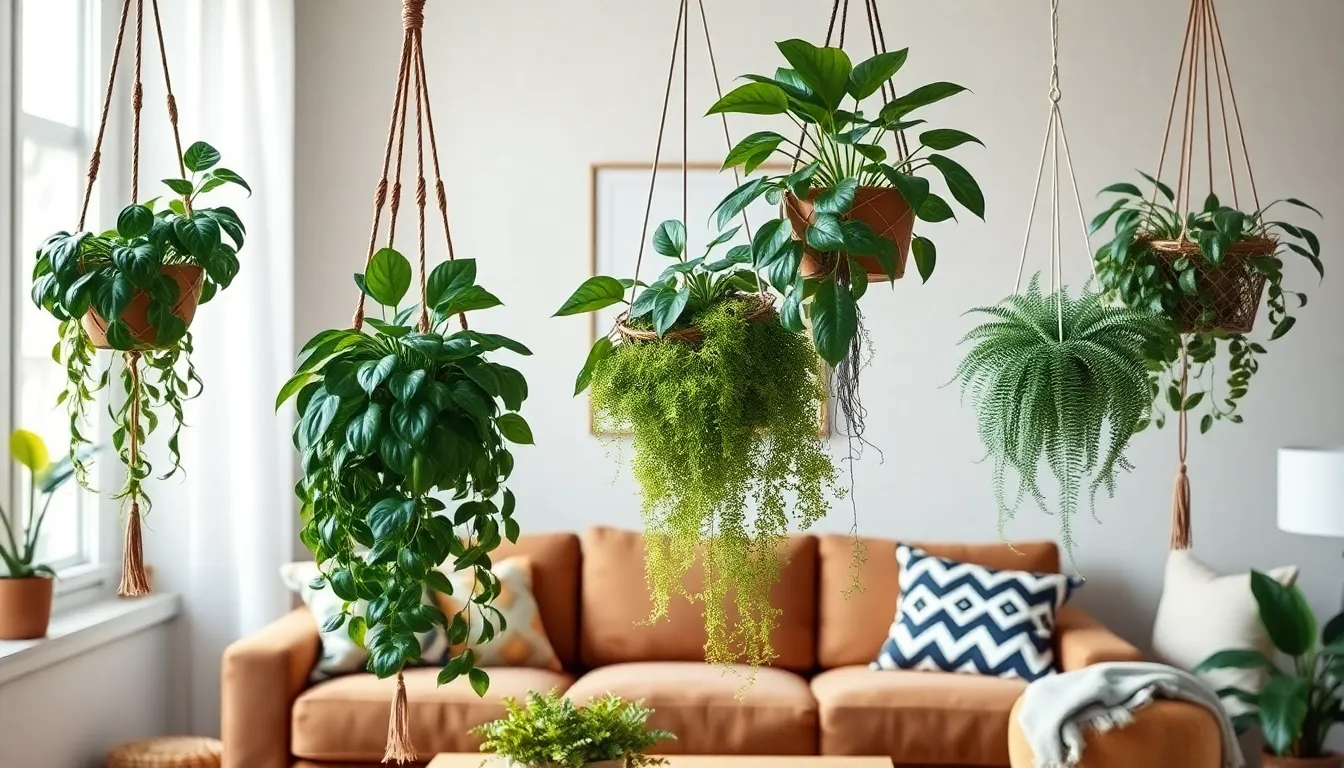
Now that we’ve established proper placement and care routines, let’s explore how strategic arrangement techniques can transform your hanging plants into a visually stunning focal point.
Varying Heights and Levels
Creating depth through varying heights makes your hanging plant display more ever-changing and visually interesting. We achieve this lush, layered look by positioning plants at different elevations throughout the room, which naturally draws the eye upward and creates dimension.
Grouping plants in clusters at different heights works exceptionally well for maximum impact. For instance, we can pair a trailing pothos at the highest point with a bushy fern positioned slightly lower and a small succulent hanging at the lowest level. This three-tier approach adds important depth to any corner or wall space.
Different types of hangers enhance this height variation while adding character to the display. Macramé hangers offer adjustable lengths and bohemian charm, while metal hangers provide sleek lines for modern spaces. We can also use unconventional hanging spots like curtain rods, exposed beams, or even towel bars to create unexpected levels throughout the room.
Grouping Plants by Size
Strategic grouping by size creates visual balance and prevents any single plant from overwhelming the space. We follow the rule of three when possible, as odd numbers naturally create more balanced and pleasing arrangements than even groupings.
Large statement plants like fiddle leaf figs work best as anchor points in our groupings. We then complement these with medium-sized bushy plants such as Boston ferns, adding smaller trailing varieties like string of pearls to complete the composition. This size progression creates a natural flow that feels intentional rather than random.
Weight distribution becomes crucial when grouping plants of different sizes. We ensure our ceiling hooks and hanging hardware can support the combined weight, especially when clustering multiple plants in one area. Testing the strength of our installation points prevents accidents and protects both plants and furniture below.
Mixing Textures and Colors
Combining different textures and colors transforms ordinary plant arrangements into captivating living art. We create visual interest by pairing plants with contrasting leaf shapes, such as the broad, glossy leaves of a Monstera alongside the delicate, feathery foliage of a maidenhair fern.
Color variation adds striking contrasts that make each plant stand out while maintaining harmony. Green remains our foundation, but we incorporate purple tones from plants like purple heart, chartreuse hues from golden pothos, and silvery accents from plants like string of nickels. These color combinations create depth without overwhelming the overall green theme.
Trailing vine textures work beautifully when mixed with upright, bushy growth patterns. We might combine the cascading vines of a pothos with the structured form of a snake plant and the delicate fronds of a Boston fern. This texture variety keeps the eye engaged and prevents the display from appearing monotonous or flat.
Troubleshoot Common Living Room Hanging Plant Problems
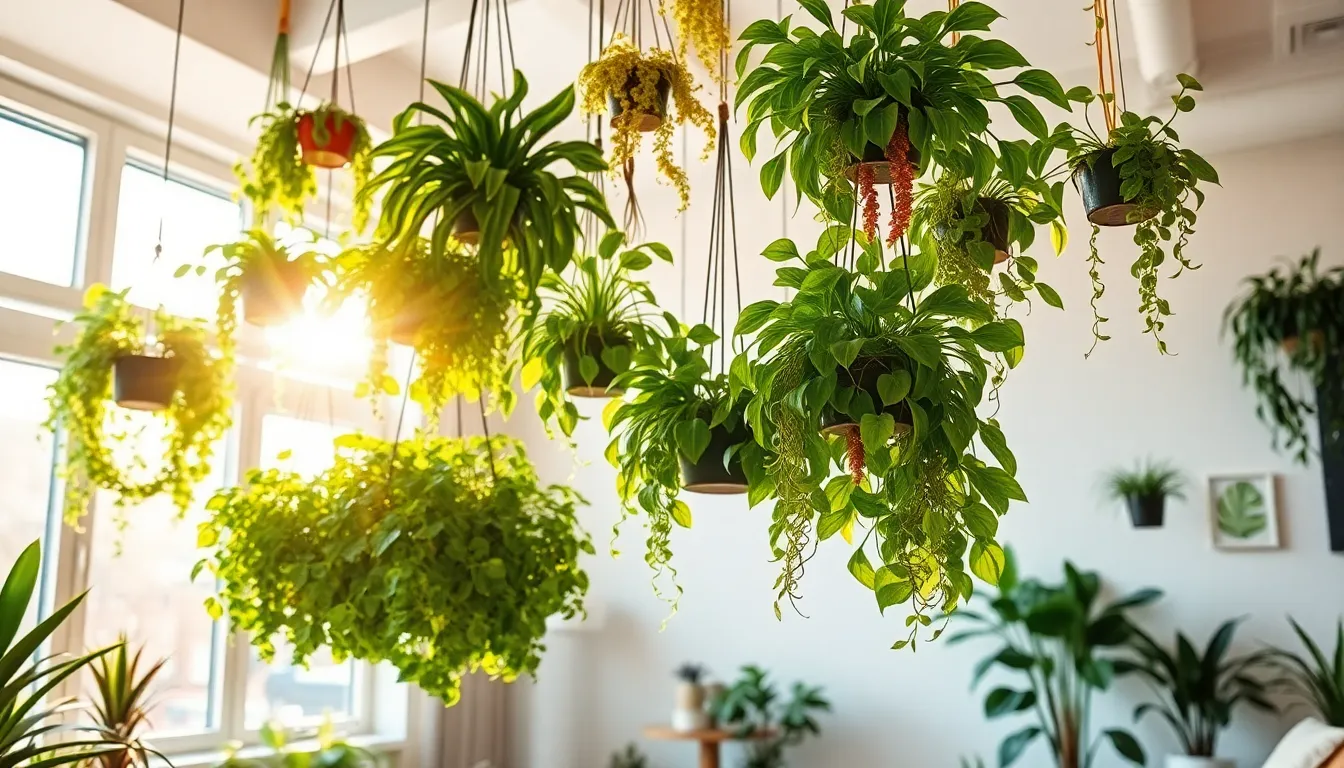
Even with perfect placement and arrangement, our hanging plants can face challenges that affect their health and appearance. Understanding how to identify and solve these issues keeps our living room greenery thriving year round.
Dealing with Insufficient Light
Recognizing light deficiency shows up as pale leaves, leggy growth, and reduced flowering in our hanging plants. Most hanging plants need bright indirect light to maintain their vibrant colors and compact growth patterns.
Moving plants closer to windows provides the easiest solution when natural light feels inadequate. We can also rotate our plants weekly to ensure all sides receive equal light exposure.
Choosing low light tolerant varieties like pothos, philodendrons, and certain ferns works best for darker living rooms. These plants adapt well to limited light conditions while still providing beautiful cascading foliage.
Installing grow lights supplements natural lighting when window placement isn’t enough. LED grow lights positioned 12 to 18 inches above our plants can extend their daily light exposure by 4 to 6 hours.
Managing Overwatering Issues
Overwatering becomes particularly problematic with hanging plants because they typically have limited soil volume and restricted drainage options. Root rot develops quickly when water sits stagnant in containers.
Using containers with drainage holes prevents water from accumulating at the bottom of our planters. Double potting with a decorative outer pot catches excess water while allowing proper drainage through the inner pot.
Monitoring soil moisture frequently helps us maintain consistent watering without overdoing it. Hanging plants dry out faster than floor plants, so we check the top inch of soil every few days.
Installing self watering containers maintains proper moisture levels automatically without creating waterlogged conditions. These systems release water gradually as the soil dries out, reducing our maintenance while preventing overwatering.
Allowing soil to dry moderately between waterings encourages healthy root development. We wait until the top 1 to 2 inches of soil feel dry before adding more water.
Preventing Pest Infestations
Indoor hanging plants attract common pests like spider mites, aphids, and mealybugs that thrive in warm, still air conditions. Regular inspection catches infestations before they spread throughout our plant collection.
Examining leaves and stems weekly reveals early signs of pest activity such as tiny webs, sticky residue, or discolored spots. We check both the upper and lower surfaces of leaves where pests often hide.
Maintaining good air circulation around our hanging plants discourages pest development. Ceiling fans or strategically placed small fans create gentle air movement that pests find less hospitable.
Quarantining new plants for 2 to 3 weeks before introducing them to our living room prevents pest transfer. We keep new additions in a separate room while monitoring for any signs of infestation.
Applying natural pest controls like neem oil or insecticidal soap treats infestations without harsh chemicals. We spray affected plants in the evening to avoid leaf burn and repeat treatments every 5 to 7 days until pests disappear.
Avoiding excessive humidity reduces the moisture levels that many pests need to reproduce. We maintain humidity between 40% to 60% for plant health while discouraging pest populations.
Style Your Space with Complementary Decor Elements
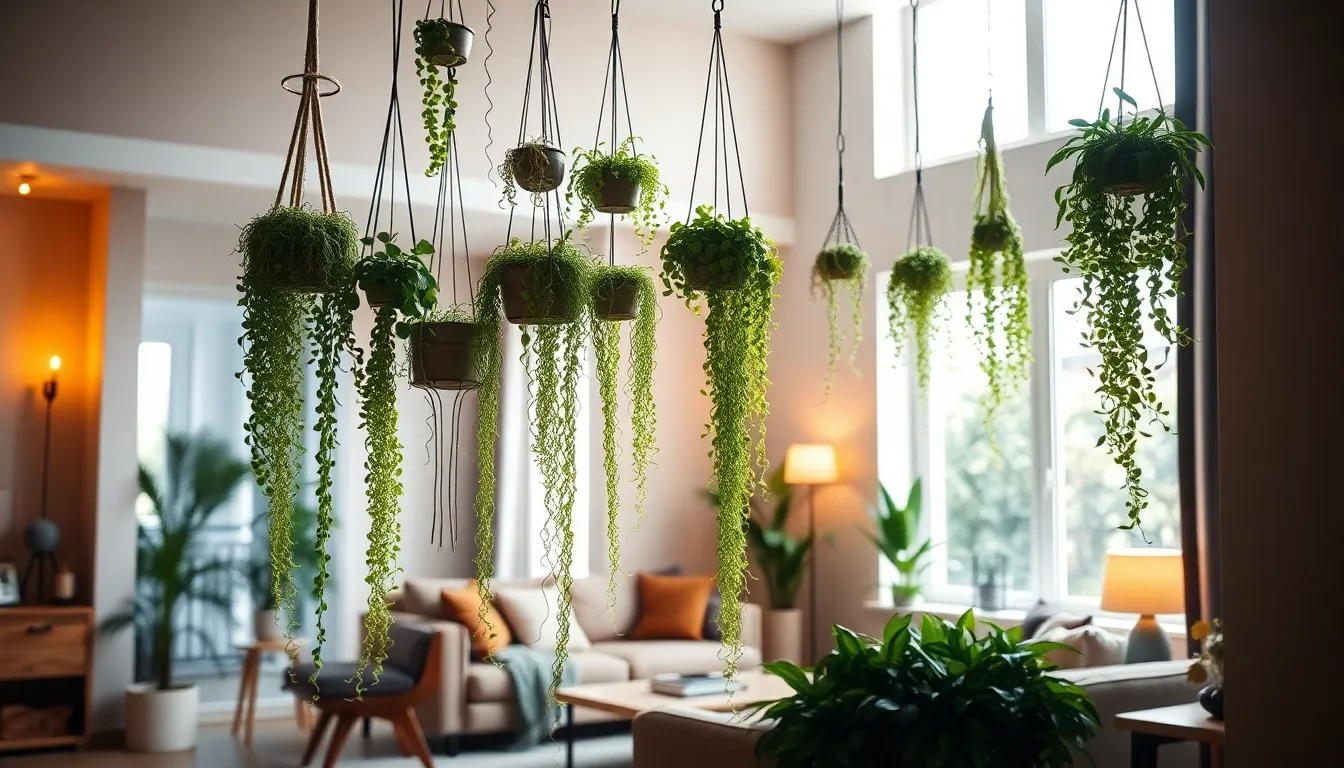
Creating a cohesive living room design means thoughtfully integrating your hanging plants with existing decor to achieve visual harmony throughout the space.
Coordinating with Existing Furniture
Matching plant holders to your furniture’s material and color scheme creates seamless visual flow. Choose wooden hangers when you have wood furniture pieces, or opt for sleek metal holders to complement modern interiors. Position hanging plants near seating areas to create natural focal points without cluttering your coffee table or side table surfaces.
Curtain rods and wall brackets offer smart integration opportunities with your existing window treatments. We recommend suspending plants from these architectural features to maximize both functionality and style. Strategic placement above your sofa or armchairs draws the eye upward while maintaining conversation areas below.
Scale matters when coordinating plants with furniture proportions. Large trailing plants like pothos work beautifully above substantial sectional sofas, while delicate philodendrons complement smaller accent chairs. Your plant containers should echo the finish of nearby furniture legs or hardware for a polished, intentional look.
Adding Accent Lighting
Spotlights and adjustable LED lamps highlight your plant foliage while creating dramatic shadows for added depth. Position these fixtures to cast gentle illumination on cascading leaves, transforming your hanging plants into living art pieces. We’ve found that warm white LED bulbs enhance the natural green tones without overwhelming the space.
String lights intertwined with hanging plants deliver cozy, whimsical ambiance for evening gatherings. These fairy lights work particularly well with trailing varieties like English ivy or hoya, creating magical pools of soft light throughout your living room. Battery operated options eliminate the need for additional electrical work.
Natural light positioning maximizes both plant health and visual appeal. Place your hanging plants near windows where they’ll receive optimal growing conditions while serving as living window treatments. The interplay between natural and artificial lighting creates ever-changing visual interest throughout different times of day.
Incorporating Natural Elements
Mixing hanging plants with floor plants and terrariums builds a cohesive botanical theme. We suggest combining your suspended greenery with potted plants at varying heights to create layers of natural texture. This approach transforms your living room into an indoor garden sanctuary.
Organic materials in plant hangers reinforce the natural aesthetic you’re creating. Choose jute rope, macrame cord, or bamboo holders that complement your plants’ organic beauty. These materials add textural interest while maintaining the earth friendly vibe.
Natural wood furniture paired with stone or ceramic accessories amplifies the earthy atmosphere. Wooden shelves, woven baskets, and terracotta planters create visual connections between your hanging plants and other room elements. We recommend using these complementary pieces to establish a unified natural theme that feels both intentional and effortless.
Conclusion
We’ve explored how hanging plants can transform your living room into a vibrant and healthier space. From selecting the right varieties for your lighting conditions to choosing stylish containers that complement your décor these green additions offer endless possibilities for improving your home.
With proper installation techniques and consistent care routines you’ll enjoy thriving plants that purify your air and create stunning visual displays. Remember that mixing different textures heights and colors while considering your existing furniture creates the most impactful arrangements.
Whether you’re dealing with low light conditions or pet safety concerns there’s a hanging plant solution that’ll work perfectly for your unique living space. Start small with easy-care varieties and gradually build your collection as you gain confidence in your plant parenting skills.
Frequently Asked Questions
What are the best hanging plants for beginners with no gardening experience?
Pothos and spider plants are perfect for beginners due to their low-maintenance nature. These resilient plants tolerate various lighting conditions, require minimal watering, and are forgiving if you forget to care for them occasionally. They’re also fast-growing and provide immediate visual impact in any living room.
How do I choose hanging plants for a low-light living room?
Select varieties like pothos, ZZ plants, or compact snake plants that thrive in dim environments. These low-light tolerant species can survive with minimal natural light while still adding visual appeal. Consider supplementing with grow lights if your room receives very little sunlight throughout the day.
Which hanging plants are safe for homes with pets?
Boston ferns, spider plants, and prayer plants are excellent pet-safe options. These non-toxic varieties allow pet owners to enjoy beautiful greenery without worrying about their furry friends’ safety. Always research specific plant toxicity before bringing new plants into pet-friendly homes.
What types of hanging planters work best for living rooms?
Macrame plant hangers offer bohemian charm and versatility, ceramic and terracotta pots provide durability with superior drainage, and modern metal planters create sleek contemporary looks. Choose based on your décor style and plant needs, ensuring proper drainage for plant health.
Where should I position hanging plants for maximum visual impact?
Place plants near windows to create “living curtains” that filter natural light, transform empty corners into focal points with cascading varieties, and hang plants above furniture to create layered design effects. Strategic placement enhances room layout while ensuring plants receive adequate light.
How do I install hanging plants without damaging my ceiling?
Use ceiling hooks for heavier plants, swag hooks with toggle bolts for drywall, or wall-mounted brackets for versatile positioning. For renters, consider no-drill tension rods for lighter plants. Always test hook strength and distribute weight evenly to prevent damage.
How often should I water my hanging plants?
Follow a weekly watering schedule, adjusting frequency based on environmental factors like humidity and temperature. Check soil moisture before watering and ensure pots have drainage holes to prevent root rot. Use saucers to catch excess water and protect surfaces.
How can I arrange multiple hanging plants for the best look?
Create visual depth using a three-tier approach with plants at different heights. Group plants by size for balance, follow the rule of three for pleasing arrangements, and mix textures and colors for dynamic displays. Vary leaf shapes and color combinations for captivating living art.
What are common problems with hanging plants and how do I fix them?
Common issues include insufficient light, overwatering, and pest infestations. Move plants closer to windows or add grow lights for light problems, use proper drainage and monitor soil moisture for watering issues, and maintain good air circulation with regular inspections for pest control.
How do I integrate hanging plants with my existing décor?
Coordinate plant holders with furniture materials and colors, position plants strategically near seating areas, and use accent lighting to enhance visual appeal. Mix hanging plants with floor plants for cohesive botanical themes, and choose organic materials for hangers to reinforce natural aesthetics.

